They call it “mud season”: the annual period at a ski resort when the snow has melted, tourism is down, and the gondolas are used only for scenic trips to the top of the mountain. While some of the shops close until the next snowfall, many resort towns try to attract visitors through their marketplaces, community activities and cool temperatures. Back in 1995, Howard and Cathy Stone 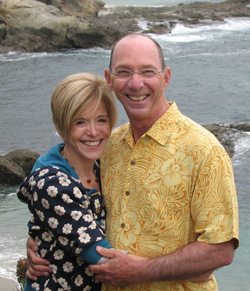 hosted their first jazz party in Vail, Colorado. The party has become a Labor Day weekend tradition, and in recent years, it has blossomed into a summer-long jazz festival, with 40 concerts presented this year. The jazz party remains the primary event of the summer, and this year’s edition was one of the finest. With the support of the Arrabelle Hotel and the local merchants, the daytime performances were held in an open tent in the Lionshead town square, where shoppers and passers-by could enjoy the music (The patrons and musicians were under the cover of the tent, which was a blessing in light of Vail’s frequent and sudden thunderstorms). In the evenings, the party moved to the spacious ballroom of the Marriott Hotel.
hosted their first jazz party in Vail, Colorado. The party has become a Labor Day weekend tradition, and in recent years, it has blossomed into a summer-long jazz festival, with 40 concerts presented this year. The jazz party remains the primary event of the summer, and this year’s edition was one of the finest. With the support of the Arrabelle Hotel and the local merchants, the daytime performances were held in an open tent in the Lionshead town square, where shoppers and passers-by could enjoy the music (The patrons and musicians were under the cover of the tent, which was a blessing in light of Vail’s frequent and sudden thunderstorms). In the evenings, the party moved to the spacious ballroom of the Marriott Hotel.
For the party, the Stones bring in about two dozen jazz musicians from all over the world. Most of the players are accessible mainstream musicians, but the Stones typically include a few progressive musicians to the mix. The audiences for Vail tend to be older, but they are very open-minded, and they cheer on the adventurous musicians as enthusiastically as the traditionalists. There are a few working groups and several soloists, but all of the musicians are hired for their flexibility, as they are scheduled to play in jam sessions and in ad-hoc ensembles (most organized by Howard Stone). This year’s soloists included vocalists Cyrille Aimée and Niki Haris, guitarists Diego Figueiredo and Graham Dechter, saxophonists James Carter and Houston Person, organist Bobby Floyd, trumpeter Byron Stripling, pianist Benny Green, vibraphonist Warren Wolf and drummer Ernie Adams.
Both of the working groups have long-standing ties with the Vail party. The Jeff Hamilton Trio, with Tamir Hendelman on piano and Christoph Luty on bass,  returned after a year’s absence. Their sets included several tightly arranged pieces from their recent album “Red Sparkle”, including the delightful “Hat’s Dance” which includes a break of indeterminate length, which Hendelman stretched almost to the breaking point. Luty’s rich bass sound was featured on his arrangement of “A Sleepin’ Bee” and Hamilton brilliantly maneuvered through the tricky chart on “Too Marvelous for Words”. Their final set included a tribute to the classic Ahmad Jamal Trio with a beautifully modulated rendition of “Poinciana”. The Clayton Brothers have been part of the jazz party since its
returned after a year’s absence. Their sets included several tightly arranged pieces from their recent album “Red Sparkle”, including the delightful “Hat’s Dance” which includes a break of indeterminate length, which Hendelman stretched almost to the breaking point. Luty’s rich bass sound was featured on his arrangement of “A Sleepin’ Bee” and Hamilton brilliantly maneuvered through the tricky chart on “Too Marvelous for Words”. Their final set included a tribute to the classic Ahmad Jamal Trio with a beautifully modulated rendition of “Poinciana”. The Clayton Brothers have been part of the jazz party since its 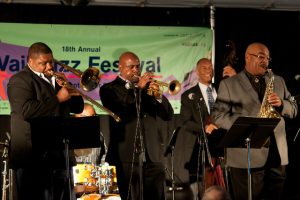 first year, and this year, bassist John and saxophonist Jeff expanded their quintet to include another jazz party favorite, trombonist Wycliffe Gordon. The Clayton sextet also included trumpeter Terell Stafford, pianist Bill Cunliffe and drummer Lewis Nash. While Cunliffe and Nash are not regular members of the Clayton Brothers group, they have been part of the Vail version of the band for many years and they fit into the band’s groove with little effort. The sextet played a burning set to close the Sunday night festivities, featuring selections from their upcoming album “The Gathering”. Jeff Clayton played a beautiful alto solo on Benny Carter’s “Souvenir” and John Clayton filled the ballroom with his glorious arco bass on “Round Midnight”.
first year, and this year, bassist John and saxophonist Jeff expanded their quintet to include another jazz party favorite, trombonist Wycliffe Gordon. The Clayton sextet also included trumpeter Terell Stafford, pianist Bill Cunliffe and drummer Lewis Nash. While Cunliffe and Nash are not regular members of the Clayton Brothers group, they have been part of the Vail version of the band for many years and they fit into the band’s groove with little effort. The sextet played a burning set to close the Sunday night festivities, featuring selections from their upcoming album “The Gathering”. Jeff Clayton played a beautiful alto solo on Benny Carter’s “Souvenir” and John Clayton filled the ballroom with his glorious arco bass on “Round Midnight”.
The Clayton Brothers Sextet is also the faculty for the Vail Jazz Workshop, an intensive 10-day training program for high-school aged musicians. Twelve finalists are chosen from recorded auditions (a pair each of trumpeters, trombonists, saxophonists, pianists, bassists and drummers) and while at the workshop, they play as a large ensemble and in two smaller groups. All of the music is learned by ear, and the students are encouraged to compose pieces for the group. At the end of the workshop, they play three concerts at the jazz 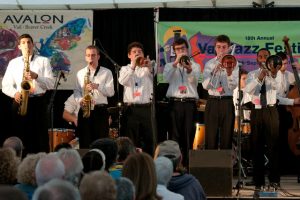 party. Dubbed the Vail Jazz All-Stars, this year’s group included trumpeters Aidan Lombard and Nathan Sparks, trombonists Coleman Hughes and Cameron Kerl, alto saxophonist David Milazzo, tenor saxophonist Daniel Berkey, pianists Jeremy Corren and James Francies, bassists Maximilian Gerl and Andrew Sommer, and drummers Cameron Macintosh and Zachary McKinney. Most of the music they played was from the 1960s repertoire of Art Blakey’s Jazz Messengers and other Blue Note ensembles. These young musicians are still finding their own solo voices, but they have a great enthusiasm for the music and their talents are closer to college upperclassmen than high school students.
party. Dubbed the Vail Jazz All-Stars, this year’s group included trumpeters Aidan Lombard and Nathan Sparks, trombonists Coleman Hughes and Cameron Kerl, alto saxophonist David Milazzo, tenor saxophonist Daniel Berkey, pianists Jeremy Corren and James Francies, bassists Maximilian Gerl and Andrew Sommer, and drummers Cameron Macintosh and Zachary McKinney. Most of the music they played was from the 1960s repertoire of Art Blakey’s Jazz Messengers and other Blue Note ensembles. These young musicians are still finding their own solo voices, but they have a great enthusiasm for the music and their talents are closer to college upperclassmen than high school students.
The Vail Jazz Workshop has turned out many distinguished alumni, including saxophonists Grace Kelly and Tia Fuller, and pianists Gerald Clayton and Robert Glasper. This year, the Stones brought back three other Workshop alumni, Justin Kauflin (piano), Joe Sanders (bass) and Corey Fonville (drums), to work together as a trio for Houston Person, and to play in several of the ad hoc ensembles. Although they did not work together as Workshop students, each has worked with the others on professional gigs in New York. Kauflin, who has been blind since age 11, displays a brilliant, flexible technique that fit into a wide variety of musical situations, and he quickly responded to spontaneous changes during the performances. Sanders and Fonville were a great rhythm team, locking into several enticing grooves over the weekend.
This year’s jazz party showed an increased dedication to jazz history, with multi-media tributes to jazz legends Dave Brubeck, Ray Brown and Dizzy Gillespie. These tributes included classic film clips along with live music and a 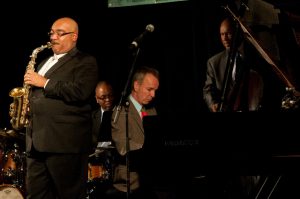 biography of the featured musicians. Each of the presenting musicians offered their own unique spin on the established format. On the Brubeck tribute, Bill Cunliffe’s quartet (with the Claytons and Lewis Nash) played Brubeck’s compositions, but let the film clips offer the story and sound of the classic Brubeck Quartet with Paul Desmond. Byron Stripling’s presentation on Gillespie was much more studious in its narration, but the filmed performances by Gillespie’s various groups and the live music by Stripling’s bebop quintet (with Jeff Clayton, Cunliffe, Sanders and Nash) made the hour-long set go by quickly. For his
biography of the featured musicians. Each of the presenting musicians offered their own unique spin on the established format. On the Brubeck tribute, Bill Cunliffe’s quartet (with the Claytons and Lewis Nash) played Brubeck’s compositions, but let the film clips offer the story and sound of the classic Brubeck Quartet with Paul Desmond. Byron Stripling’s presentation on Gillespie was much more studious in its narration, but the filmed performances by Gillespie’s various groups and the live music by Stripling’s bebop quintet (with Jeff Clayton, Cunliffe, Sanders and Nash) made the hour-long set go by quickly. For his 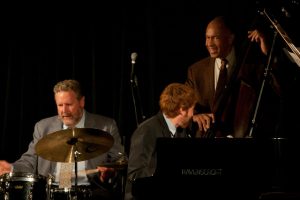 Ray Brown tribute, John Clayton brought in Benny Green and Jeff Hamilton, both of whom played in Brown’s trio. Clayton studied with Brown for many years, and now owns and plays Brown’s bass. All three musicians shared warm and funny anecdotes about Brown, and the videos showed Brown with Gillespie’s big band, the Oscar Peterson trio, and Duke Ellington. Unfortunately, the talk and the videos ate into the time for the live music. The three pieces the trio played were magnificent, including a delicate version of “Li’l Darlin’” with light articulations by Green, a brilliant performance of Brown’s original, “Buhania” with a dazzling hi-hat work by Hamilton, and a grooving arrangement of “Summer Wind” anchored by Clayton’s sturdy bass. Clearly, the audience wanted to hear more of this marvelous group. A Ray Brown tribute CD could be a great addition to the discography of these great musicians. Howard Stone and the musicians need to make it happen—and soon!
Ray Brown tribute, John Clayton brought in Benny Green and Jeff Hamilton, both of whom played in Brown’s trio. Clayton studied with Brown for many years, and now owns and plays Brown’s bass. All three musicians shared warm and funny anecdotes about Brown, and the videos showed Brown with Gillespie’s big band, the Oscar Peterson trio, and Duke Ellington. Unfortunately, the talk and the videos ate into the time for the live music. The three pieces the trio played were magnificent, including a delicate version of “Li’l Darlin’” with light articulations by Green, a brilliant performance of Brown’s original, “Buhania” with a dazzling hi-hat work by Hamilton, and a grooving arrangement of “Summer Wind” anchored by Clayton’s sturdy bass. Clearly, the audience wanted to hear more of this marvelous group. A Ray Brown tribute CD could be a great addition to the discography of these great musicians. Howard Stone and the musicians need to make it happen—and soon!
Bobby Floyd’s presentation on the Hammond B3 organ was exceptionally well-researched and it used the large video screen to show close ups of Floyd’s 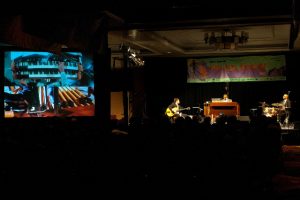 hands and feet as he manipulated the instrument. Floyd’s lecture-demonstration was scheduled to start on Saturday night at the ridiculously late hour of 10:55 PM, but despite Howard Stone’s efforts to keep the party running on schedule, Floyd didn’t start until nearly 11:30. By that time, many of the audience members decided to turn in, and they missed one of the most informative sets of the weekend. Wycliffe Gordon’s Sunday afternoon set on the history of jazz trombone was better attended, but not nearly as comprehensive. Gordon’s performances typically encapsulate many jazz styles, from tailgate to multiphonics, but his presentation was not in historical order and didn’t adequately explain the highlights of each style. However, it was easy to hear elements of Tommy Dorsey in “I’m Getting Sentimental over You”, Jack Teagarden in “Basin Street Blues” and Tricky Sam Nanton in “Talking Trombone Blues”. The program was very entertaining, especially in the closing tribute to Fred Wesley, “Pass the Peas”, but it might have been more focused with a few video clips and tighter narration.
hands and feet as he manipulated the instrument. Floyd’s lecture-demonstration was scheduled to start on Saturday night at the ridiculously late hour of 10:55 PM, but despite Howard Stone’s efforts to keep the party running on schedule, Floyd didn’t start until nearly 11:30. By that time, many of the audience members decided to turn in, and they missed one of the most informative sets of the weekend. Wycliffe Gordon’s Sunday afternoon set on the history of jazz trombone was better attended, but not nearly as comprehensive. Gordon’s performances typically encapsulate many jazz styles, from tailgate to multiphonics, but his presentation was not in historical order and didn’t adequately explain the highlights of each style. However, it was easy to hear elements of Tommy Dorsey in “I’m Getting Sentimental over You”, Jack Teagarden in “Basin Street Blues” and Tricky Sam Nanton in “Talking Trombone Blues”. The program was very entertaining, especially in the closing tribute to Fred Wesley, “Pass the Peas”, but it might have been more focused with a few video clips and tighter narration.
Floyd, Gordon, Stripling and Jeff Clayton joined Niki Haris for the Sunday morning Gospel Prayer Meeting. This has been a highlight of the party for many years, and Haris (daughter of pianist Gene Harris) is the perfect leader for this segment. Her soulful readings of classic sacred hymns like “It Is Well in My Soul” and “How I Got Over” uplifted the large congregation, and she shared vocal duties with Gordon on the Leonard Cohen anthem, “Hallelujah”. Gordon provided rousing trombone throughout and Clayton provided an intense prayer midway through the service. The rhythm section of Karen Hammack (piano), Graham Dechter (guitar), Joe Sanders (bass) and Ernie Adams (drums) offered tremendous support and authentic gospel feeling. Haris also performed  two straight-ahead sets over the weekend, amply displaying her R&B inspired vocals on songs like “Let The Good Times Roll”, but also featuring beautifully sung ballads like “Where Is Love” (dedicated to her father on his birthday) and “Dream” (sung with the rarely-heard verse).
two straight-ahead sets over the weekend, amply displaying her R&B inspired vocals on songs like “Let The Good Times Roll”, but also featuring beautifully sung ballads like “Where Is Love” (dedicated to her father on his birthday) and “Dream” (sung with the rarely-heard verse).
Cyrille Aimée and Diego Figueiredo played two delightful duo sets during the party. She sang in three different languages and showedformidable prowess in scat singing. Her quick, straight-ahead performance of “Yardbird Suite” (with Charlie Parker’s original lyrics) won over the audience completely, 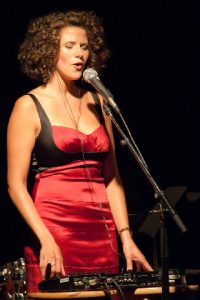 and her loop pedal performances of “Fortunate Son” and “Nuit Blanche” were stunning both in their arrangements and realizations. Figueiredo was superb in both Brazilian and jazz settings, getting a multitude of sounds from his acoustic guitar. He was also fun to watch as he swayed back and forth to the impulses of his music. There was great chemistry between the two musicians and their intimate performances brought freshness to classic Jobim pieces like “Chega de Saudade” and “Agua de Beber”.
and her loop pedal performances of “Fortunate Son” and “Nuit Blanche” were stunning both in their arrangements and realizations. Figueiredo was superb in both Brazilian and jazz settings, getting a multitude of sounds from his acoustic guitar. He was also fun to watch as he swayed back and forth to the impulses of his music. There was great chemistry between the two musicians and their intimate performances brought freshness to classic Jobim pieces like “Chega de Saudade” and “Agua de Beber”.
Houston Person was part of a B3 organ set with James Carter, Bobby Floyd, Graham Dechter and Corey Fonville. Both 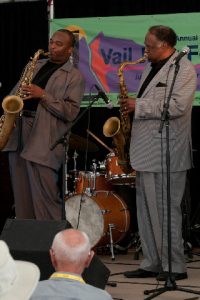 Carter and Person have recorded with organ trios, and the juxtaposition of Person’s classic soul tenor with Carter’s outrageous progressivism was mind-boggling. Person also led two afternoon sets on his own, featuring Terell Stafford on Sunday and Byron Stripling on Monday. Stafford is best-known as a fiery trumpeter in the Freddie Hubbard tradition, but I love to hear him play ballads, and on his set with Person, he was featured on warm renditions of “You Don’t Know What Love Is” and “I Remember Clifford”. The set with Stripling was a relaxed affair dedicated to what Person called “music for Saturday night—after midnight”. Stripling sang a spirited version of “Back O’Town Blues” and his bright trumpeting provided a great contrast to Person’s mellow tenor on a 12/8 version of “Since I Fell For You”. On “Back O’Town”, Stripling told the audience that “showers of bacon grease would drip from Houston’s horn”. It was true then, but it actually seemed to happen every time Person played a solo.
Carter and Person have recorded with organ trios, and the juxtaposition of Person’s classic soul tenor with Carter’s outrageous progressivism was mind-boggling. Person also led two afternoon sets on his own, featuring Terell Stafford on Sunday and Byron Stripling on Monday. Stafford is best-known as a fiery trumpeter in the Freddie Hubbard tradition, but I love to hear him play ballads, and on his set with Person, he was featured on warm renditions of “You Don’t Know What Love Is” and “I Remember Clifford”. The set with Stripling was a relaxed affair dedicated to what Person called “music for Saturday night—after midnight”. Stripling sang a spirited version of “Back O’Town Blues” and his bright trumpeting provided a great contrast to Person’s mellow tenor on a 12/8 version of “Since I Fell For You”. On “Back O’Town”, Stripling told the audience that “showers of bacon grease would drip from Houston’s horn”. It was true then, but it actually seemed to happen every time Person played a solo.
There’s a lot of camaraderie between the musicians at Vail, and before Benny Green took the stage for his Saturday afternoon performance, his fellow pianist Tamir Hendelman told him to “have a joyful set”. The music that followed was one of the highlights of the entire weekend. On the opening “I’ve Never Been in Love Before”, Ernie Adams set up a tight groove with Joe Saunders, and Green leaned into the piano to lock in the rhythm. By the second tune, a speedy “It’s You Or No One”, the groove was so well established that Green could play flurries of notes against the rhythm without losing the basic pulse. Stafford was in prime form with dynamic solos on “Doxy” and “Byrdlike”. On “I’m Beginning to See the Light” (with surprise guest vocalist Cyrille Aimée), Stafford even evoked the sound of Louis Armstrong!
Stafford, Gordon and Carter were all spark plugs for the party, guaranteed to 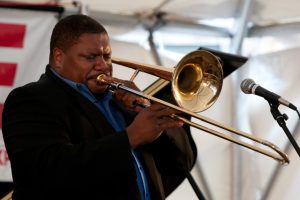 enliven any performance, even if they only appeared for one number. Warren Wolf’s Saturday afternoon set started out rather blandly, but when Gordon came out for a plunger-muted version of“Body and Soul”, the energy level went up across the stage, and stayed that way through Gordon’s Armstrong-inspired vocal during “On the Sunny Side of the Street” and for his rare progressive playing on “A Shade of Jade”. Gordon showed his tender side in an understated trio performance of “Autumn Leaves” with Cyrille Aimée and Diego Figueiredo. A set with Carter, Wolf, Green, Christoph Luty and Lewis Nash provided an avalanche of notes with exuberant performances of “Confirmation”, “Rapid Shave” and “Don’s Idea”. And at one of the after-hours jam sessions, Stafford and Carter nearly blew the roof off the hotel on a grooving version of “Straight No Chaser”.
enliven any performance, even if they only appeared for one number. Warren Wolf’s Saturday afternoon set started out rather blandly, but when Gordon came out for a plunger-muted version of“Body and Soul”, the energy level went up across the stage, and stayed that way through Gordon’s Armstrong-inspired vocal during “On the Sunny Side of the Street” and for his rare progressive playing on “A Shade of Jade”. Gordon showed his tender side in an understated trio performance of “Autumn Leaves” with Cyrille Aimée and Diego Figueiredo. A set with Carter, Wolf, Green, Christoph Luty and Lewis Nash provided an avalanche of notes with exuberant performances of “Confirmation”, “Rapid Shave” and “Don’s Idea”. And at one of the after-hours jam sessions, Stafford and Carter nearly blew the roof off the hotel on a grooving version of “Straight No Chaser”.
With major jazz festivals occurring in Chicago and Detroit over the Labor Day weekend, one might think that Howard and Cathy Stone might have difficulty attracting musicians for the Vail Jazz Party. Actually, it’s quite the opposite. The musicians are so dedicated to the vibe and atmosphere at Vail that they ask to come back year after year. The audiences clearly love these musicians, and it’s not unusual for individual solos to receive standing ovations. The Vail Jazz Party is thriving, with greater attendance than ever before and a solid reputation for musical excellence. It’s a great way to spend your Labor Day weekend.
Photographs by Drew Winners for the Vail Jazz Festival. DWinnersPhotography@gmail.com